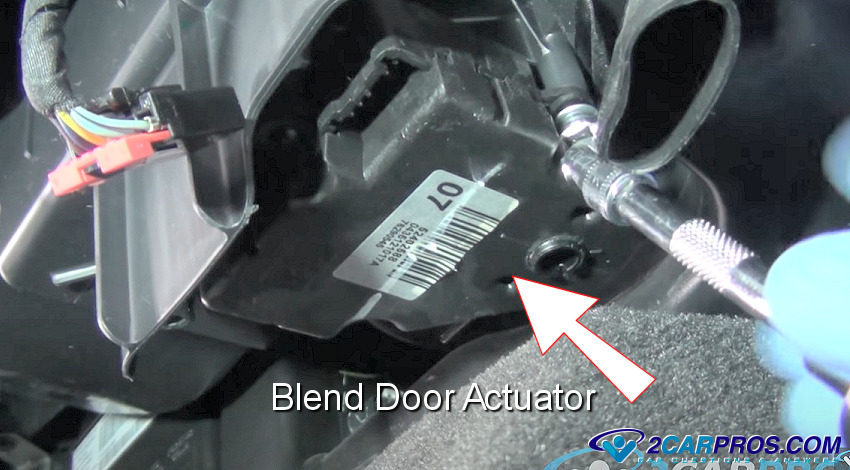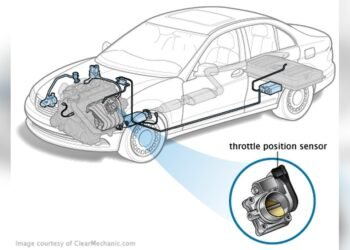To calibrate a blend door actuator, reset the vehicle’s climate control system and perform a self-diagnostic test. Ensure the vehicle’s battery is disconnected before starting the calibration process.
Calibrating a blend door actuator is a crucial step in ensuring your vehicle’s HVAC system operates smoothly. This process aligns the actuator’s movement with the commands of the climate control system, providing accurate temperature control within the cabin. Over time, actuators may require recalibration due to wear or after battery disconnection.
This task is manageable for most DIY enthusiasts and can save a trip to the mechanic. Proper calibration not only enhances comfort but also prevents further mechanical issues. By following a systematic approach, you can achieve precise control over your vehicle’s internal temperature settings, ensuring a comfortable driving experience.
Introduction To Blend Door Actuators
Blend door actuators are critical in vehicle climate control systems. They control the flow of air through the vehicle’s heating and cooling system. Positioned within the HVAC housing, actuators manage the temperature blend and distribution of air. Proper calibration ensures comfort and functionality.
Function In Vehicle Climate Control
The actuator adjusts the blend door position, dictating air temperature. It responds to driver input, allowing precise temperature settings. A well-calibrated actuator delivers consistent climate control.
Symptoms Of Misalignment
- Inconsistent cabin temperatures
- Noise from dashboard
- Weak airflow
- Temperature control issues

Credit: m.youtube.com
Tools And Materials Needed
Before calibrating a blend door actuator, gathering the right tools and materials is key. This ensures a smooth and safe process. Let’s dive into what you’ll need.
Essential Tools
- Screwdrivers: A set for different screw types.
- Socket Wrench: For bolts and nuts.
- Multimeter: To test electrical connections.
- Flashlight: For better visibility.
Safety Precautions
Working on your vehicle requires care. Here are steps to keep safe:
- Wear gloves: Protect your hands.
- Use eye protection: Keep your eyes safe.
- Disconnect battery: Prevents electrical shocks.
- Work in a ventilated area: Keeps air fresh.
Preparation Steps
Before calibrating a blend door actuator, some preparation is crucial. These steps ensure safety and efficiency during the process. Follow this guide to prepare your vehicle and access the actuator properly.
Vehicle Prep
Start by ensuring the car is on a flat surface. Turn off the ignition. Remove the keys to prevent accidental starts. Gather all necessary tools. This includes a screwdriver, flashlight, and gloves. Keep them within reach for easy access.
Accessing The Actuator
To access the actuator, first identify its location. It is usually behind the dashboard. Clear the area of any objects. This might involve removing panels or other components. Use a flashlight to illuminate the work area. This helps to spot the actuator easily.
Identifying The Blend Door Actuator
Identifying the Blend Door Actuator is key to ensuring your vehicle’s HVAC system works smoothly. The actuator controls the flow and temperature of air inside your car. It’s essential for comfort and safety. Let’s locate and inspect it.
Location Variations
The Blend Door Actuator can be in different spots, depending on the car. Most are behind the dashboard. Others may be near the footwell. Check your manual to find yours.
- Passenger Side: Common in many models.
- Driver Side: Less common, but possible.
- Center Console: Can be here in some cars.
Visual Inspection
A Visual Inspection can confirm your actuator’s health. Look for signs of wear. Check for odd noises. Feel for proper movement. These checks help spot issues early.
| Signs of Trouble | What to Do |
|---|---|
| Clicking sounds | Inspect for gear damage. |
| Irregular movement | Check for obstructions. |
| No response | Test electrical connections. |
Manual Calibration Process
The Manual Calibration Process for a blend door actuator is simple. It ensures your car’s heating and cooling system works right. Let’s dive into how you can adjust and test it yourself.
Adjustment Techniques
Adjusting the blend door actuator is easy. Follow these steps:
- Turn off your car. Make sure it’s cool.
- Find the blend door actuator. It’s usually near the glove box.
- Remove it. Use a screwdriver but be gentle.
- Manually move the blend door. Feel for any resistance.
- Put the actuator back. Screw it in firmly but not too tight.
Tip: Mark the original position before removing the actuator. It helps in putting it back correctly.
Testing For Proper Operation
After adjusting, you must test. Here’s how:
- Start your car. Let it reach a normal temperature.
- Adjust the temperature control. Go from hot to cold.
- Listen and feel. The air should change from hot to cold smoothly.
If the air does not change correctly, repeat the adjustment process. Sometimes it takes a few tries to get it right.
Remember: Always be gentle with the parts. They can break easily.
Electronic Calibration Methods
Today’s vehicles rely on precision. The blend door actuator is key for a comfortable ride. It controls the temperature flow inside your car. A misaligned actuator can mean discomfort. Let’s explore electronic calibration methods.
Using Onboard Diagnostics
Modern cars have built-in diagnostics. This system checks your actuator’s performance. Follow these steps to calibrate:
- Turn your ignition to the ‘On’ position.
- Wait for the dashboard lights to settle.
- Press and hold specific buttons for diagnostics mode.
- Watch for the actuator to start its calibration process.
- Once complete, the system will exit diagnostics mode.
Always refer to your vehicle’s manual. Each model has unique steps. This ensures accurate calibration.
Aftermarket Tools
For more control, use aftermarket tools. These tools offer advanced features. They work like this:
- Connect the tool to your vehicle’s OBD-II port.
- Select the ‘Calibrate Actuators’ option.
- Follow on-screen instructions.
These tools give detailed feedback. They also store calibration history. This is helpful for future reference.
Note: Choose a tool compatible with your car model.
Troubleshooting Common Issues
When your vehicle’s temperature control goes haywire, a faulty blend door actuator might be the culprit. Proper calibration ensures a comfortable cabin. Let’s troubleshoot two common actuator problems.
Dealing With Stuck Actuators
Stuck actuators can halt airflow regulation. This leads to incorrect cabin temperatures. Follow these steps for a fix:
- Turn off the car’s engine.
- Locate the actuator. It’s near the HVAC unit.
- Check for obstructions. Remove any found.
- Manually move the blend door. Ensure it’s free.
- Reset the system. Disconnect the battery briefly.
- Reconnect the battery. Start the car.
- Test the HVAC controls. Check for proper movement.
Electronic Faults
Electronic issues can trigger actuator malfunctions. Diagnose with these steps:
- Use a diagnostic scanner. Connect it to your car.
- Read the error codes. Look for HVAC-related ones.
- Clear the codes. Follow the scanner’s instructions.
- Test the actuator. Listen for unusual noises.
- Replace if necessary. Use an OEM part for best results.
Remember, regular maintenance prevents future problems. Keep the HVAC system clean. Check actuators during service appointments.

Credit: www.bluestarbrothers.com
Maintaining Your Hvac System
Calibrating a blend door actuator is crucial for a car’s HVAC system. It ensures comfortable cabin temperatures. Over time, actuators can lose calibration. This leads to issues with temperature regulation. A well-maintained system keeps your vehicle’s climate control in top shape.
Regular Checks
Conduct regular inspections on your HVAC system. Look for signs of wear or damage. Listen for unusual noises when changing temperature settings. Check for proper airflow from vents. Ensure the temperature matches the setting. Regular checks prevent small issues from becoming major problems.
- Inspect for wear and damage
- Listen for strange sounds
- Check airflow consistency
- Verify temperature accuracy
When To Seek Professional Help
Seek expert assistance if you notice persistent issues. This includes weak airflow, odd noises, or incorrect temperatures. Professionals have the tools to diagnose and recalibrate your system. They can handle complex problems that might be beyond DIY fixes.
| Signs You Need a Pro | Action to Take |
|---|---|
| Weak airflow from vents | Contact a certified mechanic |
| Strange noises during operation | Schedule a system diagnosis |
| Temperature doesn’t match setting | Get a professional recalibration |
Act promptly when HVAC issues arise. This ensures optimal performance and comfort in your vehicle.

Credit: www.2carpros.com
Frequently Asked Questions
What Is A Blend Door Actuator?
A blend door actuator is a device in your vehicle’s HVAC system that controls the position of the blend door to regulate cabin temperature.
Why Calibrate A Blend Door Actuator?
Calibrating a blend door actuator ensures proper functioning and accurate control of the vehicle’s heating and cooling systems.
What Signs Indicate Calibration Is Needed?
Inconsistent cabin temperatures or strange noises from the dashboard may suggest your blend door actuator requires calibration.
Can I Calibrate The Actuator Myself?
Yes, with proper guidance and tools, you can calibrate a blend door actuator yourself to save on professional service costs.
What Tools Are Required For Calibration?
Typically, you’ll need a screwdriver, your vehicle’s service manual, and sometimes a diagnostic scanner to calibrate the blend door actuator.
Conclusion
Calibrating your blend door actuator is a straightforward process that ensures your vehicle’s HVAC system operates efficiently. By following the steps outlined, you’ll achieve optimal temperature control in your car. Remember, regular maintenance is key to avoiding future issues. So, take the time to check and adjust your actuator for a comfortable driving experience.
















